Exploring China’s diverse landscapes and rich cultural heritage can be an unforgettable experience. What Areas Of China Are Good For Tourism? China offers a multitude of captivating destinations, each with its unique charm and attractions. From bustling metropolitan cities to serene natural landscapes, SIXT.VN is here to guide you through the best travel destinations. Whether you are looking for cultural immersion, historical exploration, or natural wonders, China has something to offer every traveler. Let SIXT.VN help you plan your perfect journey, ensuring a seamless and enriching travel experience.
1. Beijing: A Blend of History and Modernity
Beijing, China’s capital, is a must-visit destination offering a rich tapestry of historical sites and modern marvels. Key attractions include the Forbidden City, the Great Wall, Tiananmen Square, and the Summer Palace. However, Beijing’s charm extends beyond these famous landmarks. You can explore the traditional hutongs (alleyways), admire modern architecture, and savor Peking duck.
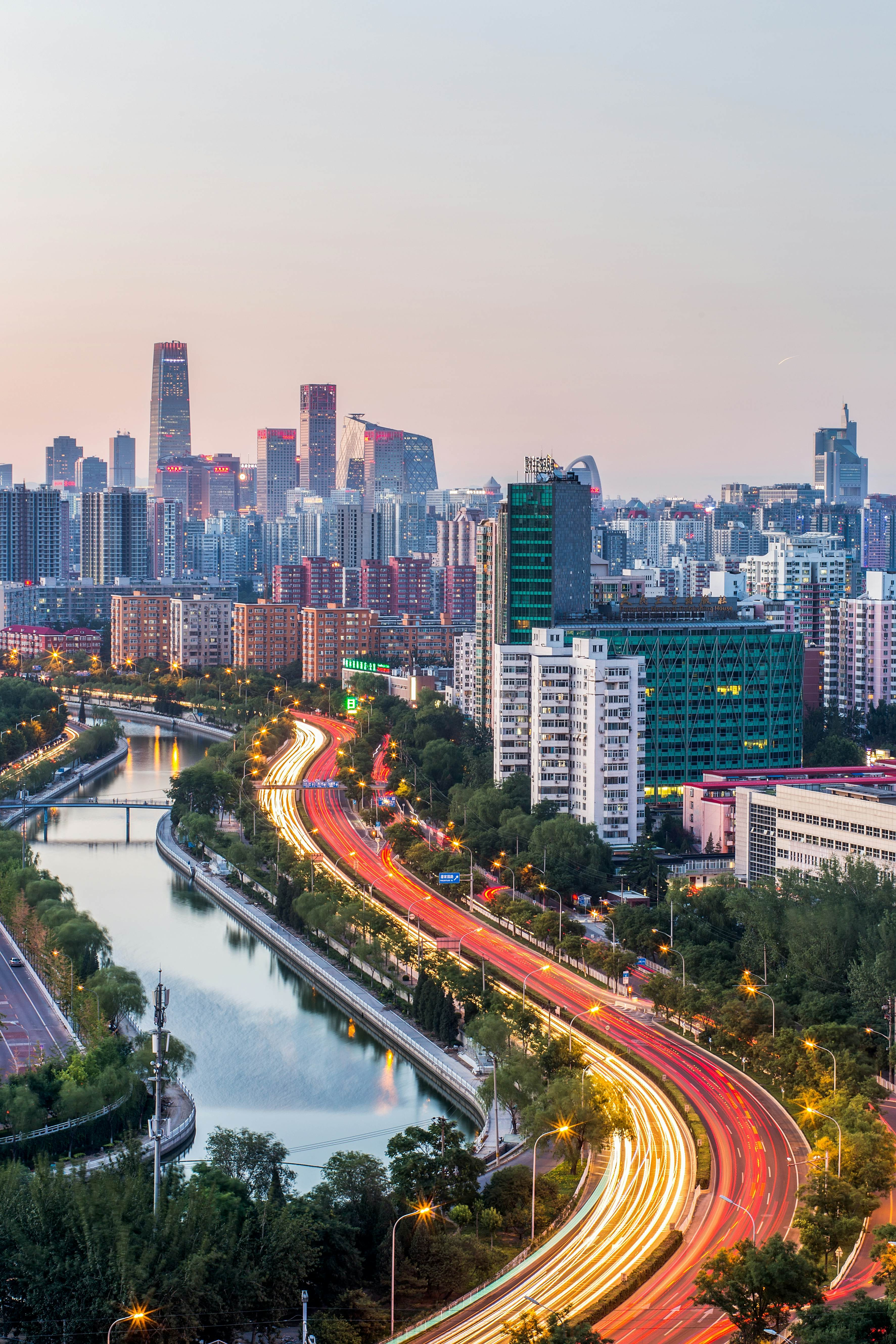 Beijing skyline
Beijing skyline
1.1 What Are the Top Historical Sites in Beijing?
Beijing is home to the Forbidden City, a UNESCO World Heritage site that served as the imperial palace for nearly 500 years, from the Ming Dynasty to the end of the Qing Dynasty, according to UNESCO. Visitors can explore its grand halls and courtyards, offering a glimpse into China’s imperial past. The Great Wall, another iconic landmark, stretches across northern China. Sections like Badaling and Mutianyu are popular for tourists, offering stunning views and a chance to walk along this ancient fortification. The Summer Palace, with its serene Kunming Lake and classical gardens, showcases imperial garden design. Tiananmen Square, one of the largest public squares in the world, holds historical significance as the site of major national events and is surrounded by important buildings like the National Museum of China and the Great Hall of the People.
1.2 What Cultural Experiences Can You Enjoy in Beijing?
Wander through the traditional hutongs to experience Beijing’s old-world charm. These narrow alleyways are lined with traditional courtyard houses, offering a glimpse into the city’s past. Enjoy Peking duck, a culinary specialty known for its crispy skin and flavorful meat. Dine at local restaurants to experience authentic Beijing cuisine. According to a study by the Beijing Tourism Administration in 2019, 85% of tourists visit local restaurants to experience authentic cuisine. Visit a traditional teahouse to enjoy Chinese tea culture. Sample different varieties of tea and learn about the art of tea preparation. Explore Beijing’s vibrant arts scene by visiting art districts like 798 Art Zone, which features contemporary art galleries and studios. Attend a Peking Opera performance to experience traditional Chinese theater, complete with elaborate costumes, makeup, and music.
1.3 What Modern Attractions Does Beijing Offer?
Admire modern architecture like the CCTV Headquarters and the National Centre for the Performing Arts, which showcase cutting-edge design. Explore shopping districts like Wangfujing and Sanlitun, which offer a mix of international brands and local boutiques. Visit the Olympic Park, site of the 2008 Summer Olympics, to see iconic structures like the Bird’s Nest stadium and the Water Cube aquatics center. Experience Beijing’s nightlife by visiting bars and clubs in areas like Sanlitun and Houhai.
2. Mogao Grottoes, Dunhuang: A Treasure Trove of Buddhist Art
Located along the ancient Silk Road, Dunhuang is home to the Mogao Grottoes, a UNESCO World Heritage site. These caves contain one of the world’s most important collections of Buddhist art, featuring murals and statues that represent the zenith of Buddhist artistry in China. The Mogao Grottoes are a must-see for art and history enthusiasts.
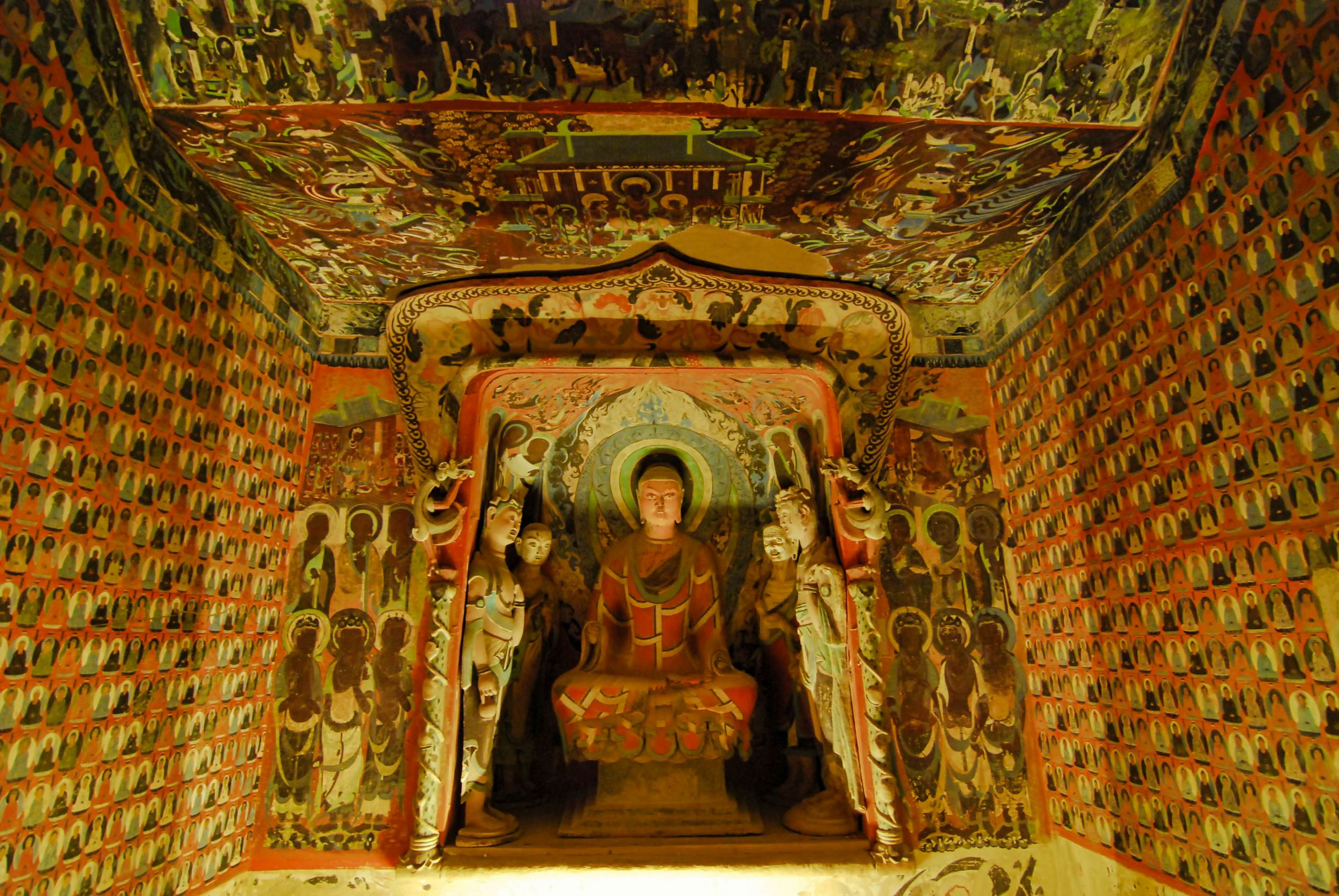 Mogao Caves, Thousand Buddha Grottoes in Dunhuang, China.
Mogao Caves, Thousand Buddha Grottoes in Dunhuang, China.
2.1 What Makes the Mogao Grottoes Significant?
The Mogao Grottoes, also known as the Thousand Buddha Grottoes, are significant for their extensive collection of Buddhist art spanning over 1,000 years, from the 4th to the 14th centuries, according to the Dunhuang Academy. The grottoes contain over 490 caves filled with murals and statues, providing insights into the artistic, religious, and cultural exchanges along the Silk Road. As a UNESCO World Heritage site, the Mogao Grottoes are recognized for their outstanding universal value in preserving Buddhist art and history.
2.2 What Can Visitors Expect to See Inside the Caves?
Visitors can expect to see a stunning array of Buddhist murals and sculptures inside the caves. The murals depict scenes from Buddhist scriptures, Jataka tales, and historical events, showcasing the evolution of Buddhist art over centuries. The statues include representations of Buddha, bodhisattvas, and other religious figures, reflecting different artistic styles and influences. Many caves feature intricate ceiling decorations and colorful paintings that cover the walls and ceilings, creating a visually immersive experience.
2.3 How Can Tourists Plan a Visit to Dunhuang and the Mogao Grottoes?
To plan a visit to Dunhuang and the Mogao Grottoes, tourists should start by booking flights or trains to Dunhuang. The Dunhuang airport and train station connect the city with major destinations in China. Visitors need to book tickets in advance, especially during peak season. Tickets can be purchased online or at the ticket office. The Mogao Grottoes limit the number of daily visitors to protect the site. Consider hiring a local guide to enhance your visit. Guides provide valuable insights into the history and art of the grottoes, enriching your understanding of the site.
3. Tiger Leaping Gorge, Yunnan: A Hiker’s Paradise
For those seeking adventure and natural beauty, Tiger Leaping Gorge in Yunnan province is an excellent choice. This 22km hiking trail winds through a World Heritage-listed gorge, offering views of snow-capped mountains and the Jinshajiang River. With depths reaching 3900m, it is one of the deepest gorges in the world, making it a memorable destination for hiking enthusiasts.
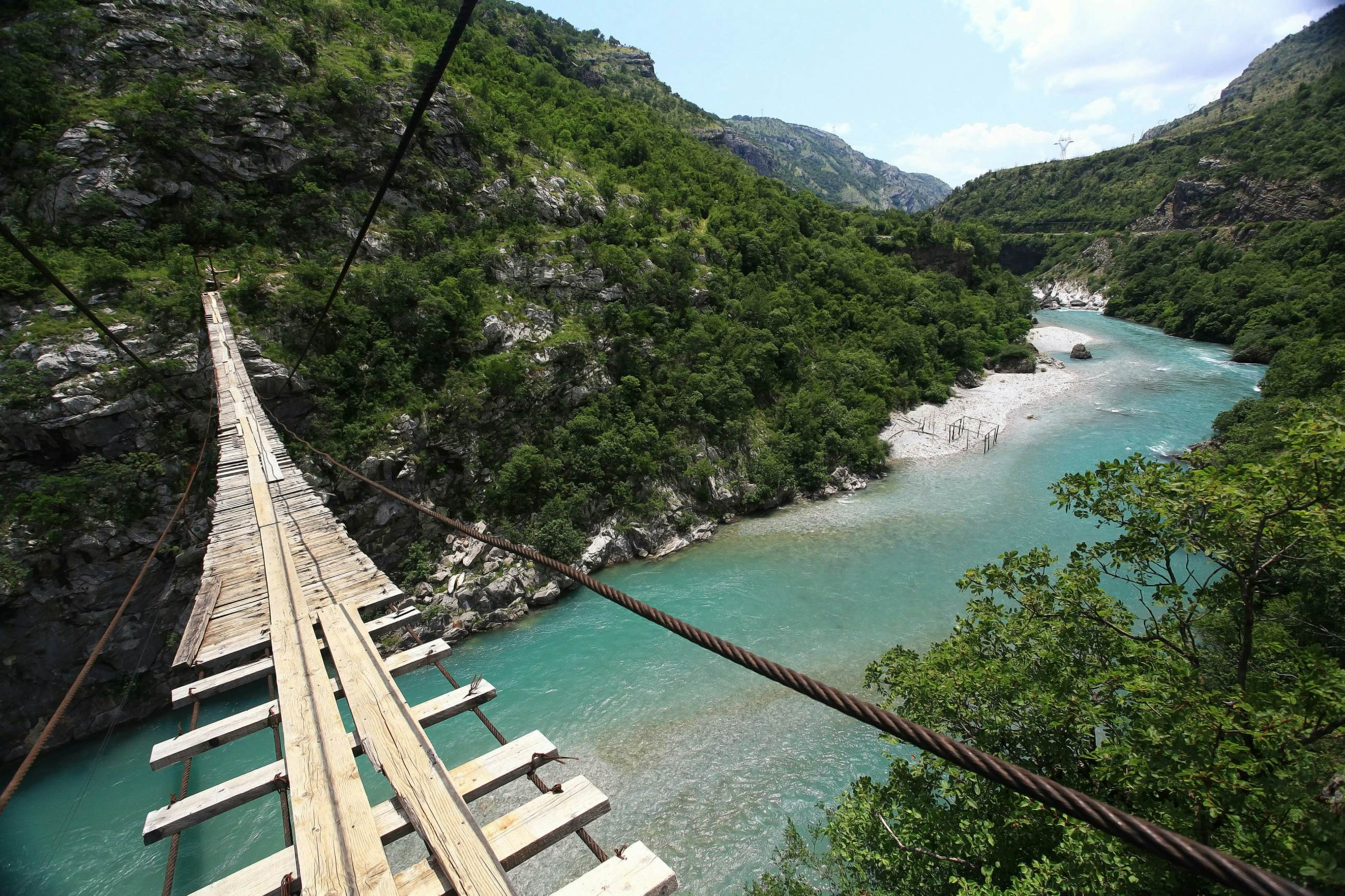 Mountain landscape a turbulent river in the gorge.
Mountain landscape a turbulent river in the gorge.
3.1 What Makes Tiger Leaping Gorge a Popular Hiking Destination?
Tiger Leaping Gorge is a popular hiking destination due to its stunning natural scenery, challenging trails, and cultural experiences. The gorge offers views of snow-capped mountains, the Jinshajiang River, and diverse landscapes, making it a visually rewarding trek, according to the Yunnan Tourism Bureau. The 22km hiking trail provides a challenging yet accessible trek for hikers of various skill levels, with options for both high and low routes. The gorge passes through local Naxi villages, allowing hikers to experience the culture and hospitality of the local people.
3.2 What Are the Different Hiking Routes Available?
The High Trail is the more challenging route, offering views and steep ascents and descents. It typically takes 2-3 days to complete. The Low Trail is an easier option that follows the river, with flatter terrain and shorter distances. It can be completed in 1-2 days. Some hikers combine sections of both trails to create a customized trekking experience.
3.3 What Should Hikers Prepare For When Visiting Tiger Leaping Gorge?
Hikers should prepare for varying weather conditions, including sunshine, rain, and temperature changes. Pack layers of clothing, including moisture-wicking fabrics, a waterproof jacket, and warm layers for the evenings. Wear sturdy hiking boots with ankle support to navigate the rugged terrain. Carry plenty of water and snacks to stay hydrated and energized during the trek. It is possible to purchase water and snacks at guesthouses along the way, but it’s best to bring your own supplies. Pack essential gear such as a map, compass or GPS device, flashlight, first-aid kit, sunscreen, hat, and sunglasses. Consider hiring a local guide to navigate the trails and provide insights into the area’s history and culture.
4. Le Shan, Sichuan: Home to the Giant Buddha
Le Shan in Sichuan province is renowned for its monumental 1200-year-old Buddha image carved directly into the rock face. Standing at the confluence of two rivers, this UNESCO World Heritage site is 71m tall and 28m wide, making it the largest ancient Buddha in the world. Visiting Le Shan is a moving experience, regardless of one’s spiritual inclinations.
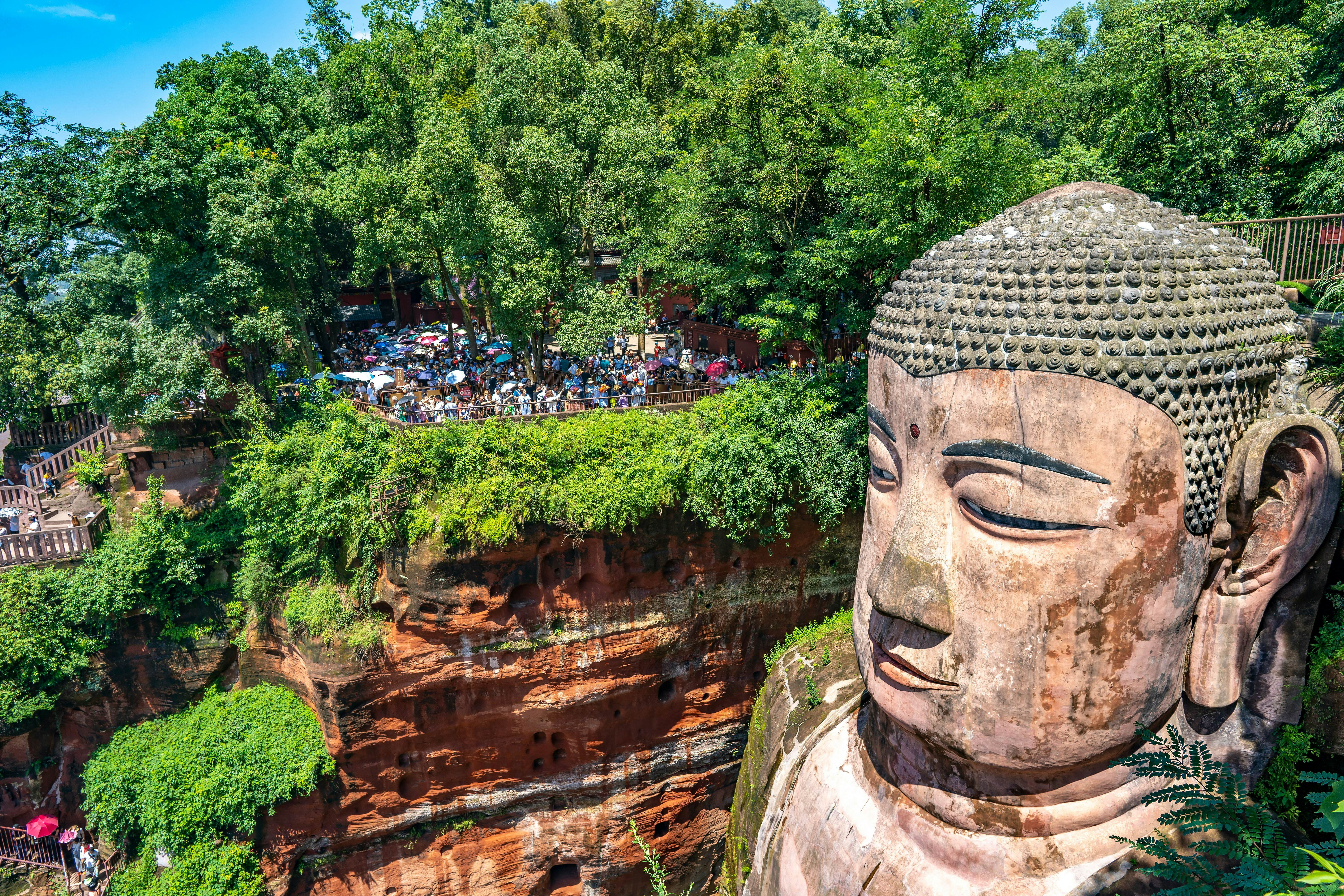 The head of the Le Shan Buddha
The head of the Le Shan Buddha
4.1 What is the Historical and Cultural Significance of the Le Shan Giant Buddha?
The Le Shan Giant Buddha holds historical and cultural significance as the largest carved stone Buddha in the world, dating back to the Tang Dynasty (713-803 AD), according to the UNESCO World Heritage Centre. The Buddha was carved to calm the turbulent waters at the confluence of the Minjiang, Dadu, and Qingyi rivers, reflecting the belief that the Buddha’s presence would protect passing boats. The construction of the Buddha involved the labor of thousands of workers over 90 years, showcasing the engineering and artistic achievements of the time. As a UNESCO World Heritage site, the Le Shan Giant Buddha is recognized for its outstanding universal value in representing the cultural and spiritual heritage of ancient China.
4.2 How Can Visitors Experience the Le Shan Giant Buddha?
Visitors can experience the Le Shan Giant Buddha by viewing it from various vantage points, including the ground, boat, and trails along the cliff. Walking trails allow visitors to climb alongside the Buddha, offering views of the statue’s head, shoulders, and body. Boat tours provide a different view of the Buddha from the river, allowing visitors to appreciate its scale and grandeur. The Lingyun Temple, located near the Buddha’s head, offers insights into Buddhist practices and the history of the site.
4.3 What Other Attractions are Near Le Shan?
The Mount Emei Scenic Area, located near Le Shan, is one of the Four Sacred Buddhist Mountains of China, featuring temples, forests, and views. The Leshan Giant Buddha Museum showcases artifacts and exhibits related to the history and construction of the Buddha. Local markets in Le Shan offer opportunities to sample Sichuan cuisine and purchase local products.
5. Shanghai: Where Past Meets Future
Shanghai is a glitzy, elegant, historic, and cosmopolitan city where China’s past blends with its future. Stroll through the French Concession or along the Bund to admire the 1920s architecture. Experience the city’s sophisticated restaurants, rooftop bars, and neon-lit skyscrapers. Shanghai vividly brings to life both the past and the future of China.
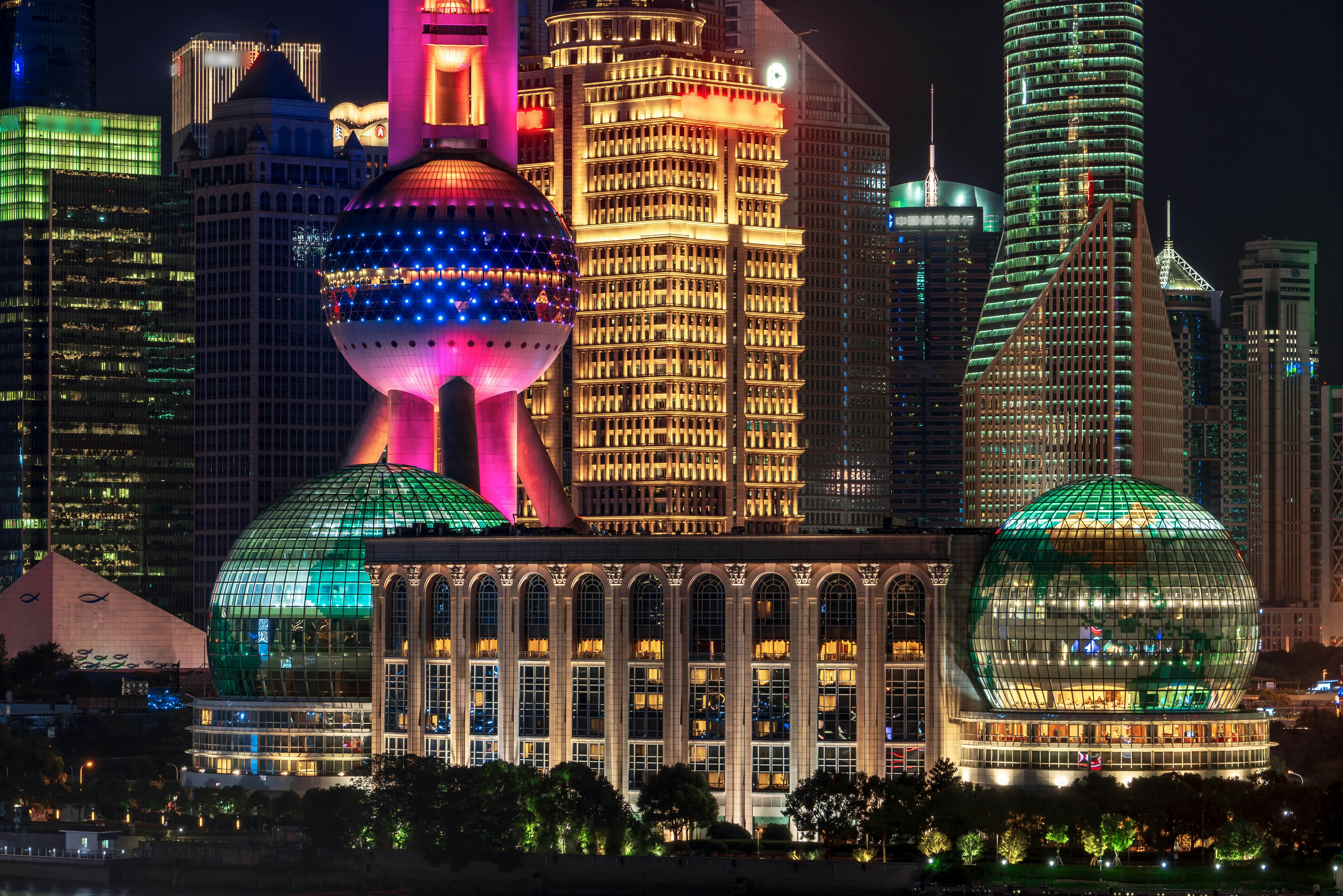 The nighttime skyline of Shanghai, China
The nighttime skyline of Shanghai, China
5.1 What Are the Must-See Attractions in Shanghai?
The Bund is a waterfront promenade featuring colonial-era buildings and views of the Pudong skyline. The French Concession is known for its tree-lined streets, historic architecture, and cafes. The Yu Garden is a classical Chinese garden with pavilions, ponds, and rockeries. The Shanghai Museum showcases Chinese art and artifacts spanning thousands of years. The Oriental Pearl Tower offers views of the city from its observation decks.
5.2 What Culinary Experiences Does Shanghai Offer?
Shanghai offers a diverse culinary scene with options ranging from traditional Chinese cuisine to international flavors. Try Xiaolongbao (soup dumplings), a Shanghai specialty. Visit local eateries and street food stalls to sample authentic dishes. Explore restaurants in the French Concession and Xintiandi for upscale dining experiences.
5.3 What Are Some Unique Experiences in Shanghai?
Take a Huangpu River cruise to see the city skyline from the water. Visit the Tianzifang art district, with its studios, galleries, and boutiques housed in traditional Shikumen buildings. Explore the Shanghai Propaganda Poster Art Centre, which displays vintage propaganda posters from the Mao era. Attend an acrobatic show to witness performances of Chinese acrobatics.
6. The Great Wall: An Iconic Landmark
The Great Wall of China is a spectacular fortification that snakes through the country’s mountainous terrain. Built over two millennia, this awe-inspiring structure stretches 21,196km long and is a true marvel of human achievement. Easily accessible from Beijing, it is a quintessential travel experience.
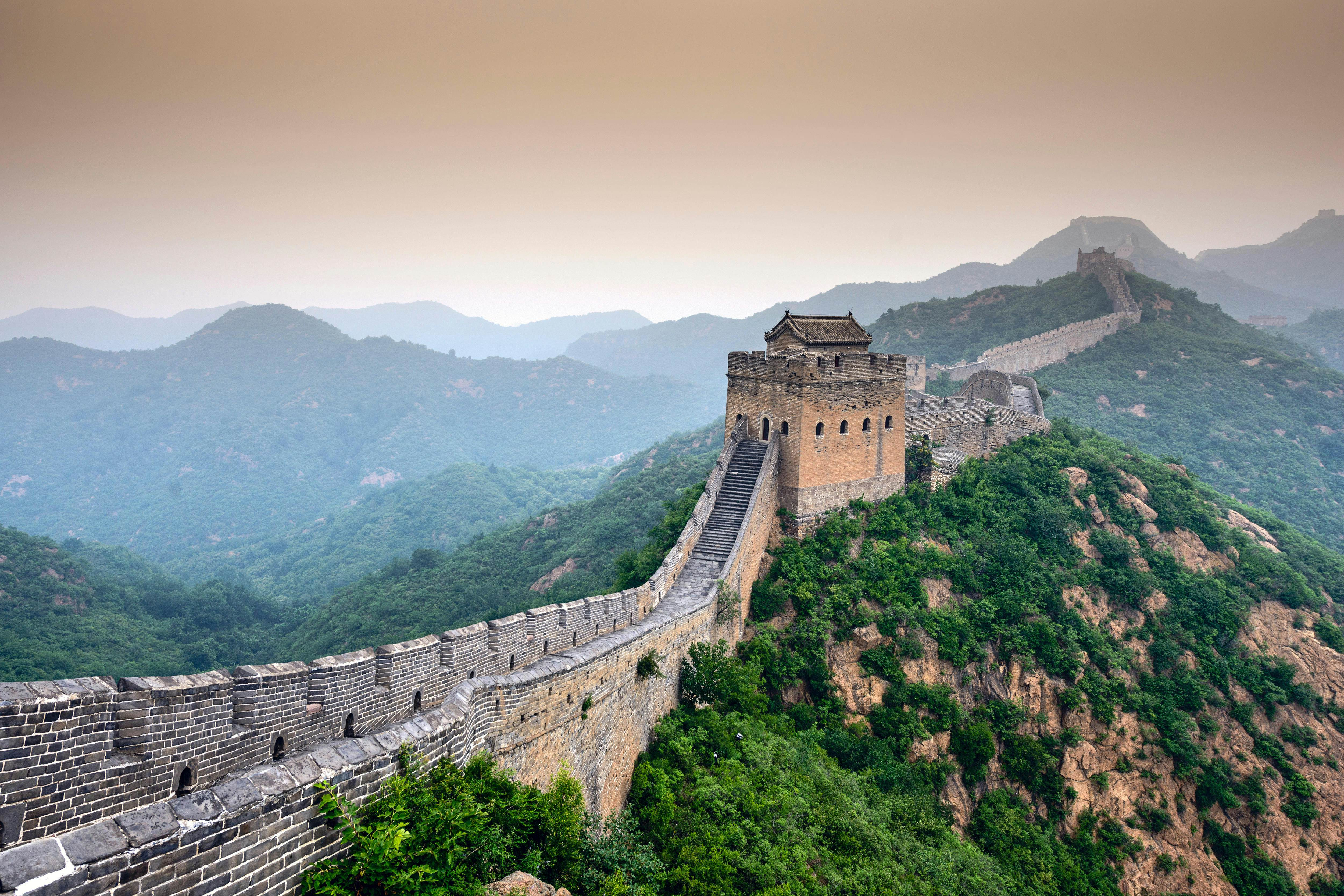 The Great Wall of China at Jinshanling.
The Great Wall of China at Jinshanling.
6.1 What Is the History Behind the Great Wall of China?
The Great Wall of China has a history spanning over two millennia, with construction beginning in the 7th century BC and continuing through the Ming Dynasty (1368-1644), according to the State Administration of Cultural Heritage. The wall was built to protect the Chinese Empire from invasions by nomadic groups from the north. Different sections of the wall were built by various dynasties, each adding to its length and fortifications. The Great Wall is not a single continuous structure but rather a series of walls, watchtowers, and fortresses built over centuries.
6.2 Which Sections of the Great Wall Are Most Accessible to Tourists?
Badaling is the most visited section of the Great Wall, known for its accessibility and restored fortifications. Mutianyu is another popular section, offering views and fewer crowds than Badaling. Simatai is known for its unrestored sections and challenging hikes, providing a more authentic experience. Jinshanling offers views and opportunities for longer hikes, connecting with Simatai.
6.3 What Activities Can Visitors Do at the Great Wall?
Visitors can hike along the wall, exploring different sections and enjoying views. Take a cable car up to sections like Badaling and Mutianyu for easier access. Visit watchtowers and fortresses to learn about the wall’s military history. Enjoy a picnic on the wall, taking in the views.
7. Chengdu: The Panda Capital
Chengdu, known for its charming teahouses, lively nightlife, and Sichuan food, is one of China’s most popular cities. Most visitors come to see pandas at the Giant Panda Breeding Research Base, where sightings are guaranteed. The city also features temples, pavilions, and museums devoted to the ancient Shu kingdom.
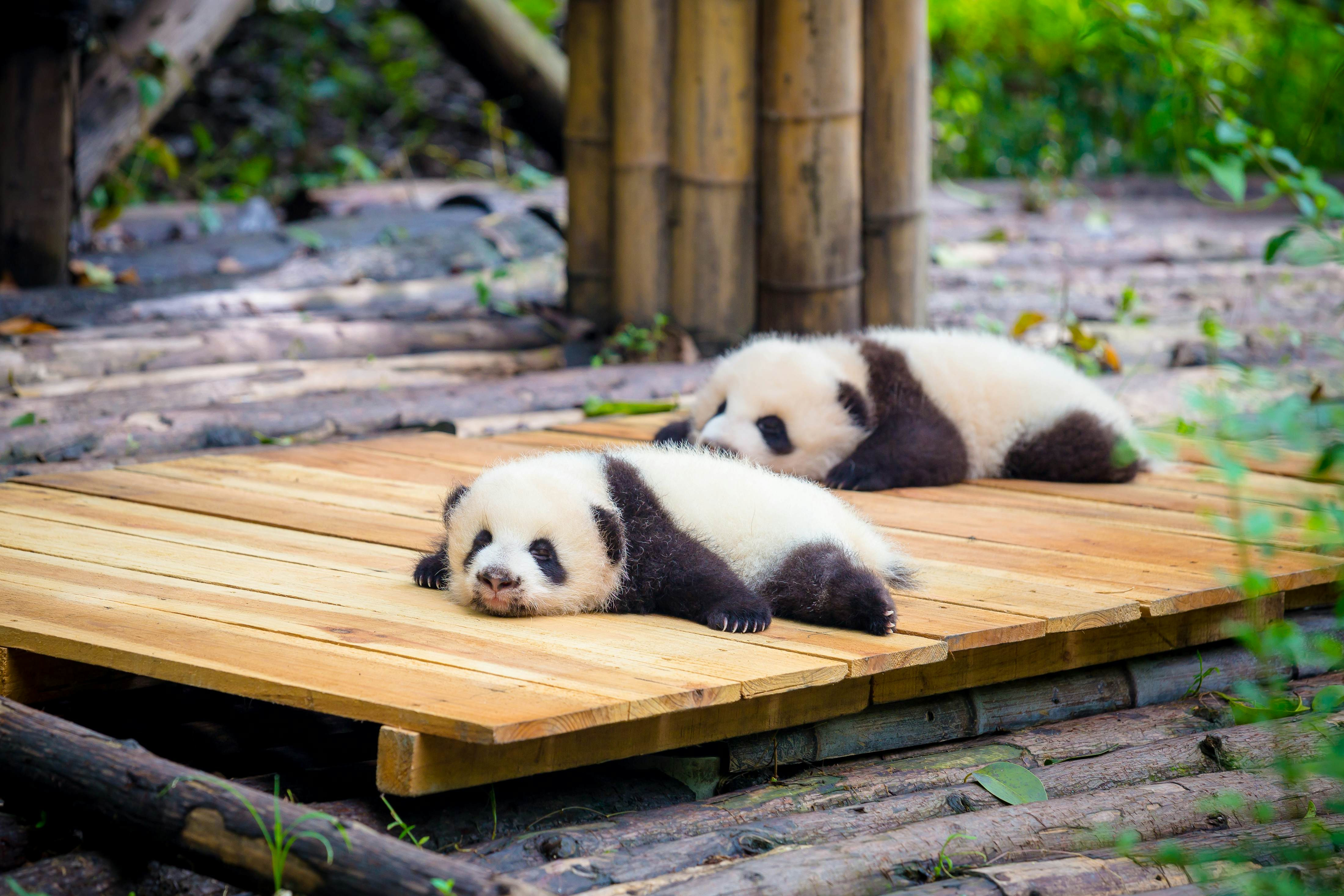 Two baby panda in Chengdu, China resting on a deck in the country
Two baby panda in Chengdu, China resting on a deck in the country
7.1 Why is Chengdu Known as the Panda Capital?
Chengdu is known as the panda capital because it is home to the Giant Panda Breeding Research Base, a world-renowned center dedicated to the conservation and breeding of giant pandas, according to the Chengdu Research Base of Giant Panda Breeding. The base is home to a large population of giant pandas, offering visitors opportunities to observe these animals in a natural environment. Chengdu’s climate and environment are well-suited to pandas, making it an ideal location for their conservation.
7.2 What Can Visitors See and Do at the Giant Panda Breeding Research Base?
Visitors can observe giant pandas in enclosures that mimic their natural habitat. See baby pandas in the nursery and learn about panda breeding programs. Explore exhibits and educational displays about panda biology and conservation. Walk through bamboo forests and gardens within the base.
7.3 What Other Attractions Does Chengdu Offer?
Jinli Ancient Street is a historic street with traditional architecture, shops, and food stalls. Wuhou Temple is dedicated to Zhuge Liang, a famous strategist from the Three Kingdoms period. The Sichuan Cuisine Museum showcases the history and techniques of Sichuan cuisine. People’s Park offers a relaxing atmosphere with teahouses and gardens.
8. Karst Peaks, Guilin: A Landscape of Natural Art
The karst-limestone peaks spanning from Guilin to Yangshuo provide an extraordinary backdrop to the Li River and rice paddies. Take a bicycle or raft to tour this beautiful countryside, passing farmers and water buffalo along the way. The landscape is truly remarkable.
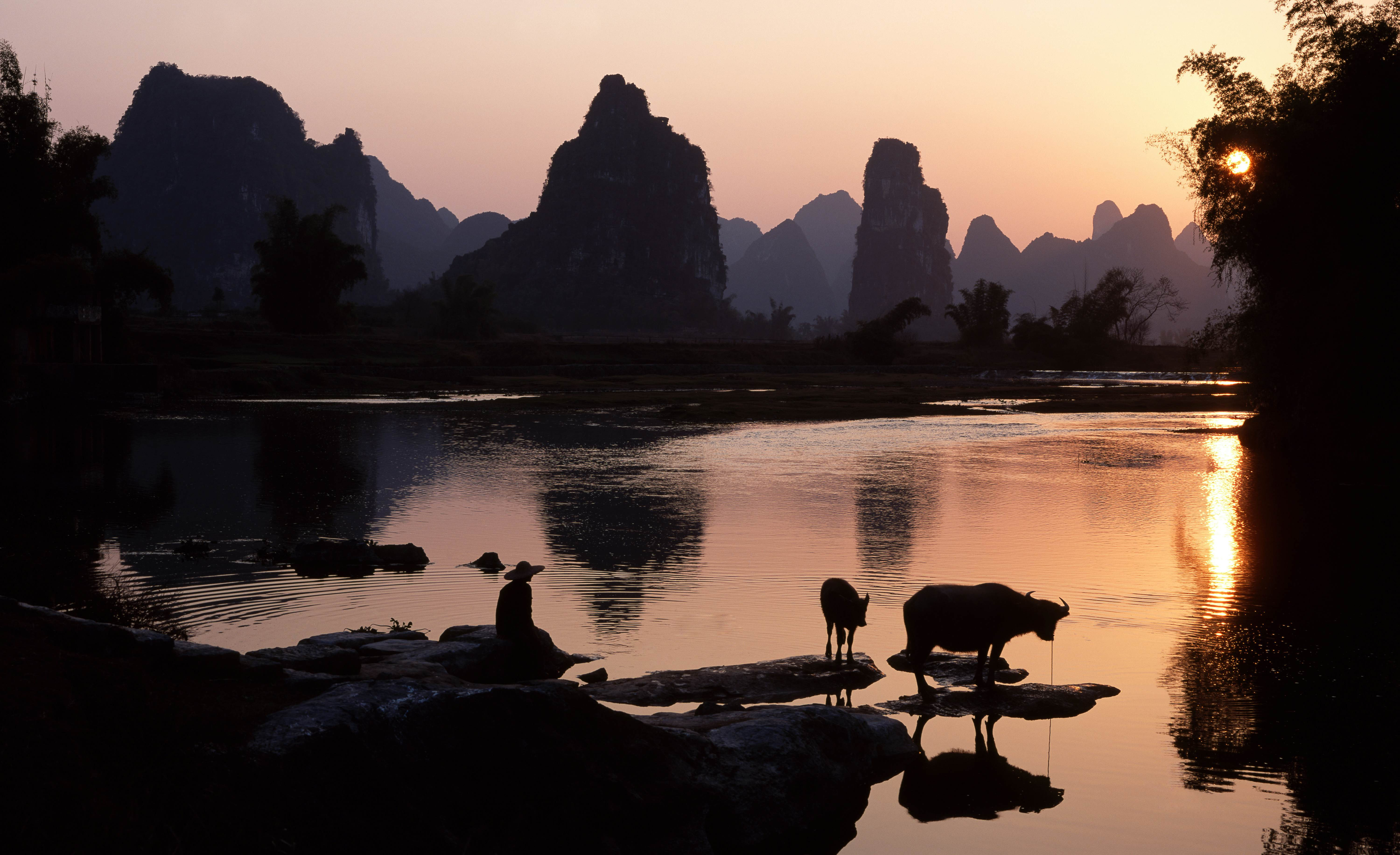 Sunset on Li River.
Sunset on Li River.
8.1 What Are Karst Peaks and Why Are They Special?
Karst peaks are geological formations created by the dissolution of soluble rocks such as limestone, resulting in unique and dramatic landscapes, according to the Geological Society of America. The karst peaks in Guilin are special because they are among the world’s best examples of karst topography, with thousands of hills and peaks rising from the plains. The Li River meanders through the karst landscape, creating a scenic and picturesque environment.
8.2 What Activities Can Tourists Enjoy in the Guilin-Yangshuo Area?
Take a Li River cruise to see the karst peaks from the water. Rent a bicycle and explore the countryside, passing through rice paddies and villages. Visit the ancient town of Yangshuo, known for its West Street and nightlife. Watch the Impression Sanjie Liu light show, performed on the Li River with the karst peaks as a backdrop.
8.3 When is the Best Time to Visit Guilin and Yangshuo?
The best time to visit Guilin and Yangshuo is during the spring (March-May) and autumn (September-November) months, when the weather is mild and comfortable. Summer (June-August) can be hot and humid, with rain. Winter (December-February) is cooler, but the landscape remains beautiful.
9. Guangzhou: A Hub of Cantonese Cuisine
Guangzhou is a vibrant and dynamic megacity that is one of China’s most fascinating hubs. Here, skyscrapers meet ancient Buddhist temples. Cantonese cuisine lures many visitors, with some of the finest dim sum in all of China.
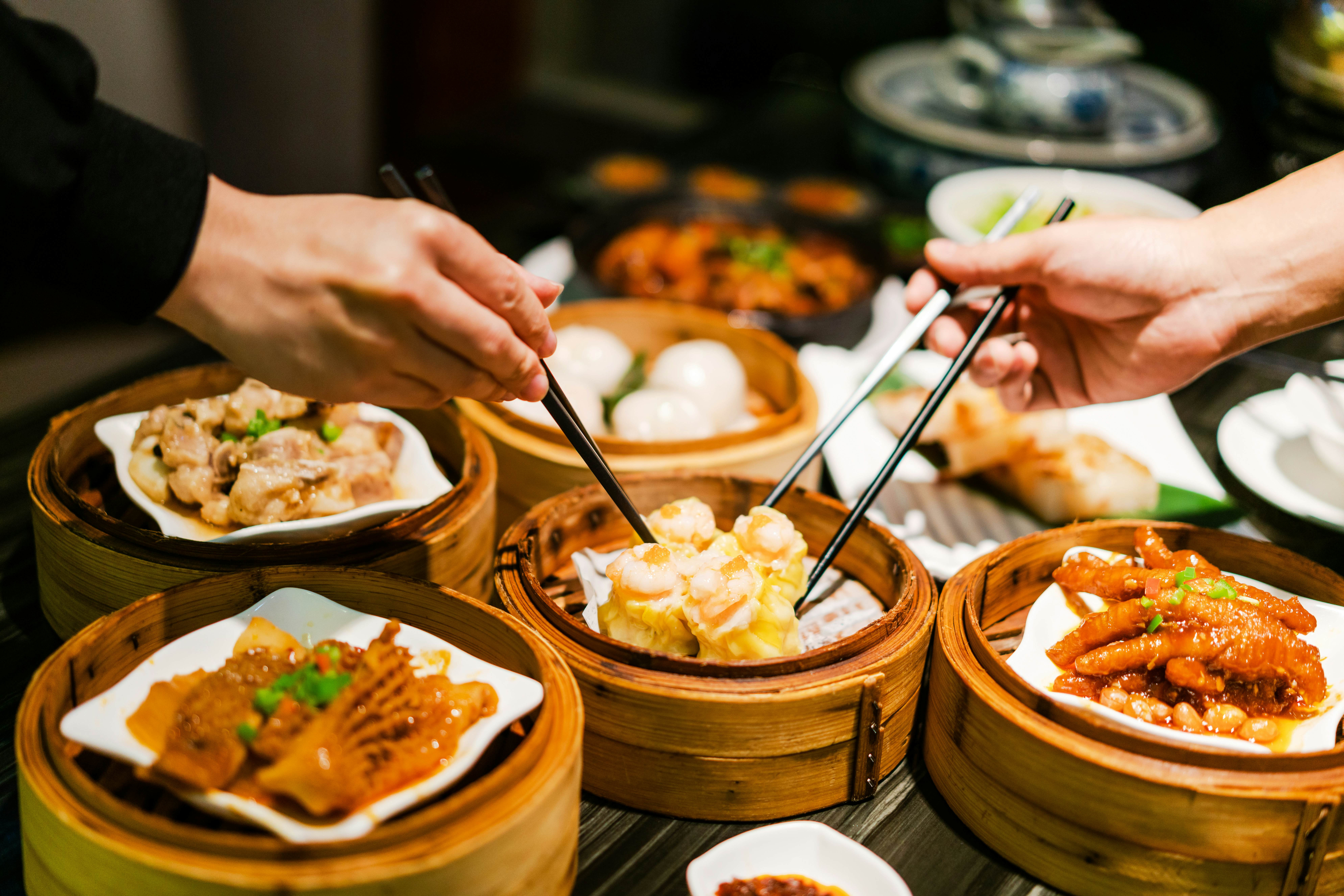 A spread of dim sum, Guangzhou, China
A spread of dim sum, Guangzhou, China
9.1 What is Guangzhou Known For?
Guangzhou is known for its history as a major trading port, its Cantonese cuisine, and its modern economic development, according to the Guangzhou Municipal Tourism Bureau. The city has a history dating back over 2,200 years and has played a role in trade and cultural exchange. Cantonese cuisine, also known as Yue cuisine, is one of the Eight Culinary Traditions of Chinese cuisine. Guangzhou is a center for trade and commerce, with numerous trade fairs and business opportunities.
9.2 Where Can Visitors Find the Best Dim Sum in Guangzhou?
Visit traditional teahouses and restaurants in the Yuexiu and Liwan districts for dim sum. Explore local eateries in the Xiguan neighborhood, known for its traditional architecture and cuisine. Check out upscale restaurants in the Tianhe district for a dim sum experience.
9.3 What Other Attractions Does Guangzhou Offer?
The Canton Tower offers views of the city from its observation decks. Shamian Island is a historic district with European-style architecture. Chen Clan Academy showcases traditional Cantonese architecture and craftsmanship. Yuexiu Park is a large park with gardens, lakes, and historical sites.
10. Longji Rice Terraces, Guangxi: Sculpted Landscapes
Rice paddies can be found all over China, but few are as spectacular as those in Longji, built against a backdrop of lush mountains. Walks here lead to viewpoints overlooking sculpted, green terraces that resemble the contours of a giant thumbprint.
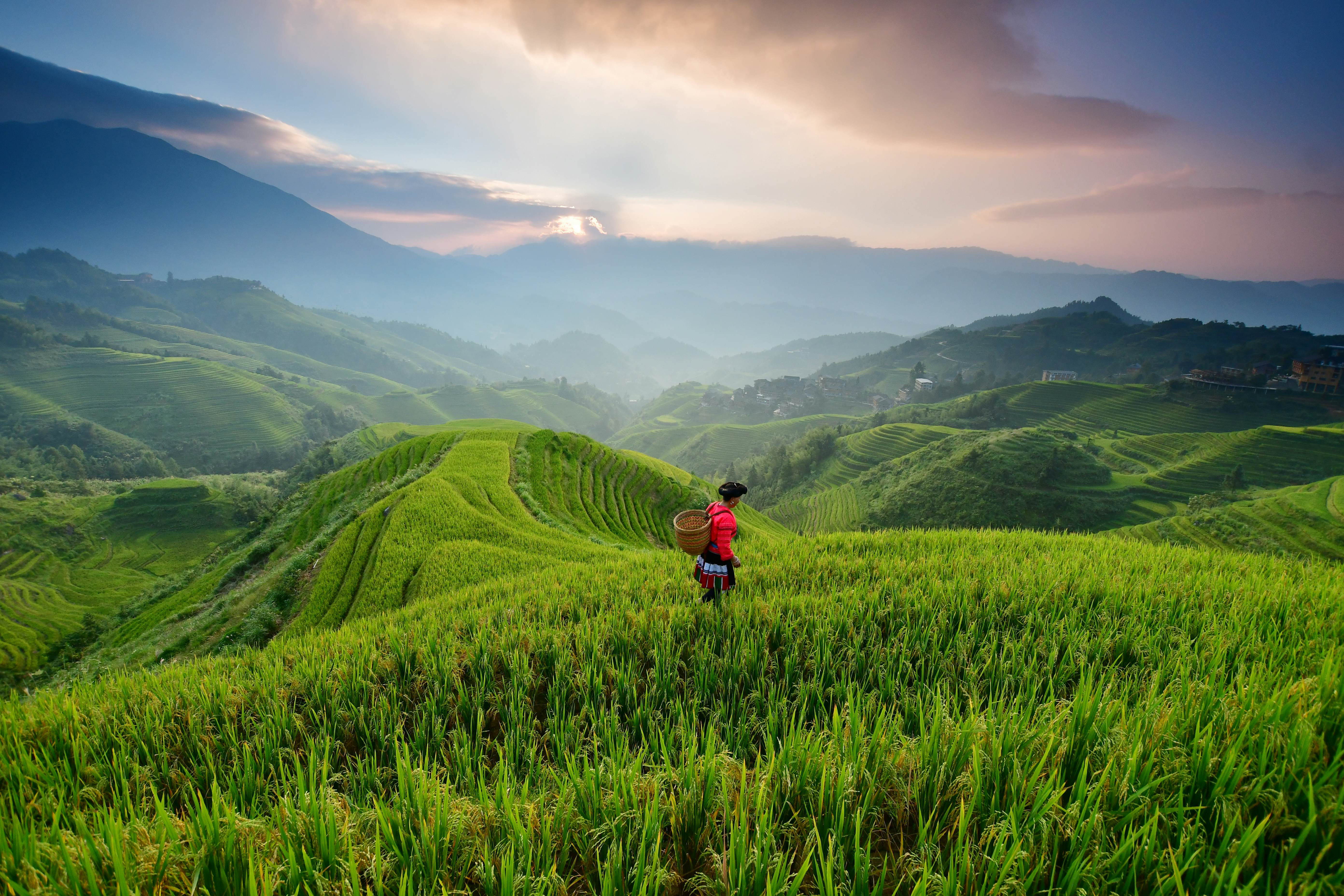 A woman in traditional dress walks through the terraced rice paddies of Longji, China
A woman in traditional dress walks through the terraced rice paddies of Longji, China
10.1 What Makes the Longji Rice Terraces Unique?
The Longji Rice Terraces are unique due to their construction on the slopes of the Longji Mountains, creating a landscape of terraced fields, according to the Guangxi Tourism Administration. The terraces were built by the Zhuang and Yao ethnic minorities, reflecting their agricultural practices and cultural heritage. The landscape changes with the seasons, offering views of flooded fields in the spring, green rice plants in the summer, golden rice fields in the autumn, and snow-covered terraces in the winter.
10.2 How Can Visitors Explore the Longji Rice Terraces?
Hike through the terraces, following trails that connect viewpoints and villages. Stay in guesthouses in villages like Ping’an and Dazhai to experience the local culture. Visit viewpoints such as Seven Stars Accompanying the Moon and Thousand Layers to see views of the terraces.
10.3 What Cultural Experiences Can Visitors Have in Longji?
Visit the villages of the Zhuang and Yao ethnic minorities to learn about their traditions, customs, and lifestyles. Attend cultural performances and festivals, such as the Dragon Boat Festival and the Torch Festival. Sample local cuisine, including rice dishes, bamboo-cooked rice, and glutinous rice cakes.
11. Terracotta Warriors, Xi’an: An Archaeological Wonder
Unearthed in Xi’an in 1974, the enigmatic army of life-sized statues remains one of the world’s most remarkable archaeological finds. Dating back 2200 years, they were built to protect the underground tomb of Emperor Qin Shi Huang. Meeting these warriors face to face is an unforgettable experience.
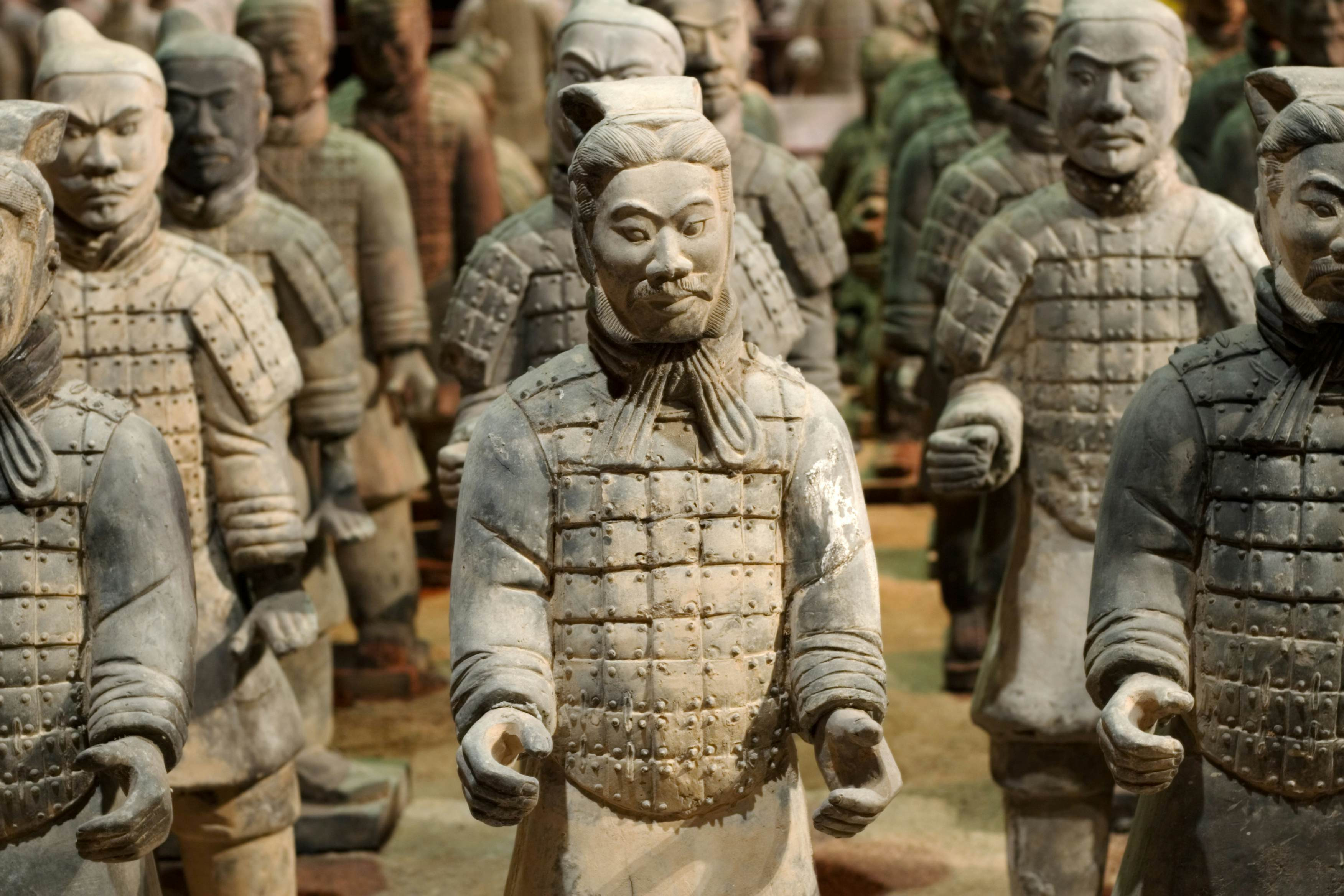 The Terracotta Warriors of Xi’an, China
The Terracotta Warriors of Xi’an, China
11.1 What Is the Significance of the Terracotta Army?
The Terracotta Army is significant as a collection of life-sized terracotta sculptures depicting the army of Qin Shi Huang, the first Emperor of China, according to the Shaanxi Provincial Cultural Relics Bureau. The army was created to accompany the Emperor in his afterlife, reflecting beliefs about immortality and the afterlife. The sculptures provide insights into the military organization, weaponry, and artistic techniques of the Qin Dynasty.
11.2 What Can Visitors See at the Terracotta Army Site?
Visitors can see thousands of terracotta warriors, horses, and chariots arranged in battle formations. Explore pits and museums that showcase the artifacts and history of the Terracotta Army. Learn about the excavation and conservation efforts at the site.
11.3 What Other Historical Sites Are Near Xi’an?
The Ancient City Wall of Xi’an is a well-preserved city wall dating back to the Ming Dynasty. The Muslim Quarter is a historic neighborhood with mosques, markets, and food stalls. The Big Wild Goose Pagoda is a Buddhist pagoda built during the Tang Dynasty. The Shaanxi History Museum showcases the history and culture of the Shaanxi province.
12. Xi’an: A City of Silk Road Lore
Xi’an is one of China’s oldest and grandest cities. Known for its Terracotta Warriors, Xi’an also marks the beginning of the Silk Road, a trade route with a legacy that remains intact within its Muslim Quarter.
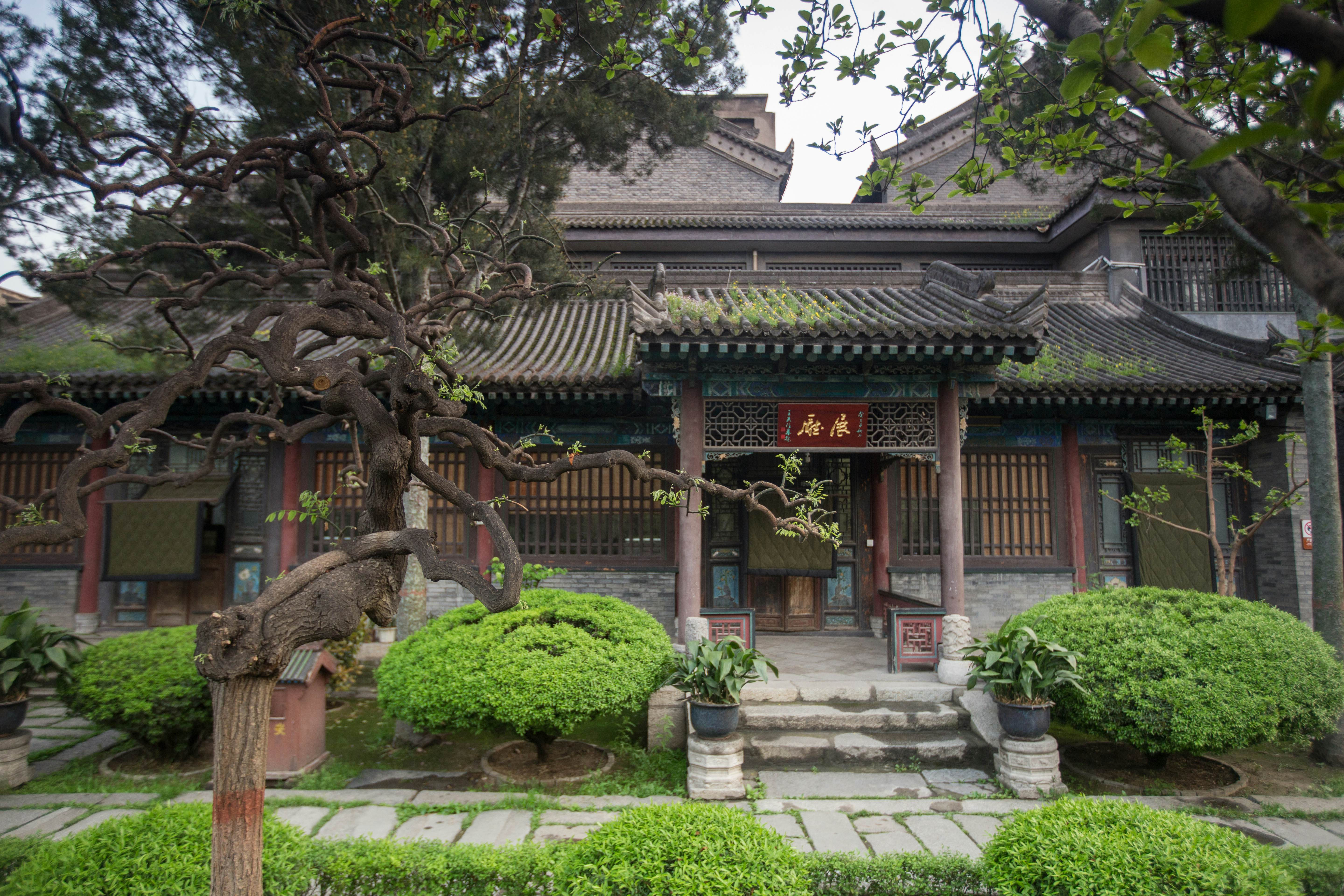 The Great Mosque in Muslim Quarter in old city.
The Great Mosque in Muslim Quarter in old city.
12.1 How Was Xi’an Important in the Silk Road?
Xi’an was important in the Silk Road as the eastern terminus of the ancient trade route, serving as a hub for the exchange of goods, ideas, and cultures between the East and West, according to the UNESCO Silk Roads Programme. The city was a center for trade, with merchants from various countries gathering to trade goods such as silk, spices, tea, and porcelain. Xi’an’s cultural diversity was influenced by its role as a Silk Road hub, with communities of foreign traders and missionaries settling in the city.
12.2 What Can Visitors Experience in Xi’an’s Muslim Quarter?
Visitors can explore the narrow streets and alleyways of the Muslim Quarter. Visit the Great Mosque of Xi’an, a historic mosque with Chinese architectural elements. Sample local cuisine, including lamb skewers, paomo (mutton soup), and rou jia mo (meat-filled buns). Shop for souvenirs and local products in the markets.
12.3 What Cultural Influences Can Be Seen in Xi’an?
Cultural influences in Xi’an reflect the city’s history as a melting pot of cultures along the Silk Road. Islamic influences can be seen in the architecture of the Great Mosque and the customs of the Muslim community. Buddhist influences are evident in the city’s temples and pagodas. Traditional Chinese culture is preserved in the city’s historical sites, cuisine, and customs.
13. Zhangjiajie: Avatar Mountains
The pinnacle rock formations of Zhangjiajie rise dramatically from the subtropical forests of northwest Hunan. These formations inspired the scenery in the film Avatar. Walk over a glass-bottom suspension bridge floating 300m above ground, and even bungee jump if you dare.
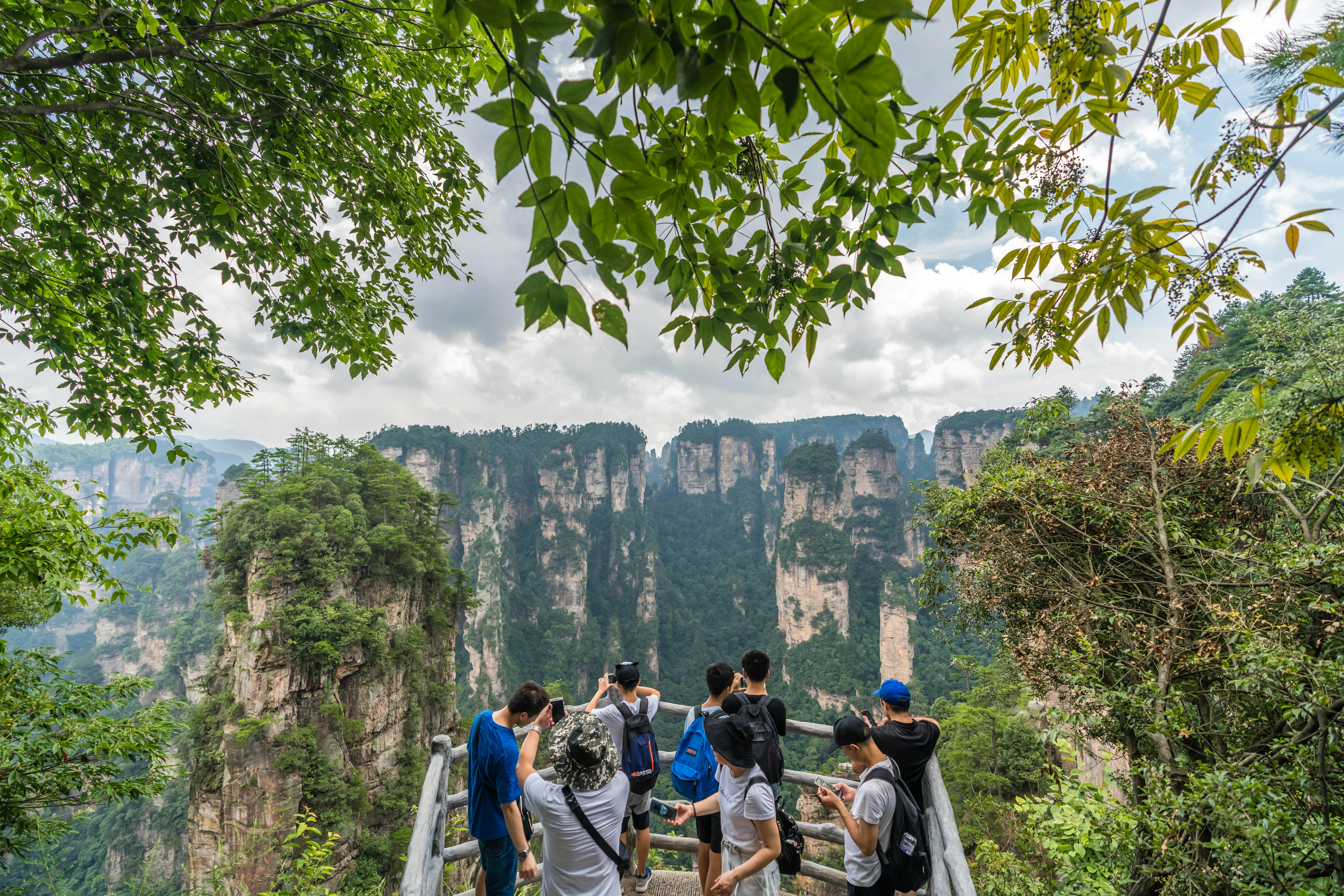 Tourist taking pictures from the viewpoint at Zhangjiajie
Tourist taking pictures from the viewpoint at Zhangjiajie
13.1 How Did Zhangjiajie Inspire the Movie Avatar?
Zhangjiajie inspired the movie Avatar with its pillar-like rock formations, which resembled the floating mountains of Pandora, according to James Cameron, the director of Avatar. The director and production designers visited Zhangjiajie to capture the landscape’s views. The film’s visual effects team used images of Zhangjiajie to create the floating mountains and surreal landscapes of Pandora.
13.2 What Activities Are Available for Adventure Seekers in Zhangjiajie?
Walk across the Zhangjiajie Glass Bridge, the world’s longest and highest glass-bottom bridge. Take the Bailong Elevator, an outdoor elevator built into the side of a cliff. Hike through the Tianzi Mountain Nature Reserve, known for its pillar-like rock formations. Ride the cable car to the top of Tianmen Mountain and walk along the glass skywalk.
13.3 What is the Best Time to Visit Zhangjiajie?
The best time to visit Zhangjiajie is during the spring (April-May) and autumn (September-October) months, when the weather is mild and comfortable. Summer (June-August) can be hot and humid, with rain. Winter (November-March) is cooler, with occasional snow.
14. Forbidden City, Beijing: A Glimpse into Imperial China
The Forbidden City in Beijing is unmatched in size, grandeur, and mystique among China’s imperial sights. Built between 1406 and 1420, this sprawling palace was off-limits for 500 years until the overthrow of the last Qing emperor in 1911. Today, it attracts nearly 20 million visitors each year. Despite the crowds, its scale remains humbling.
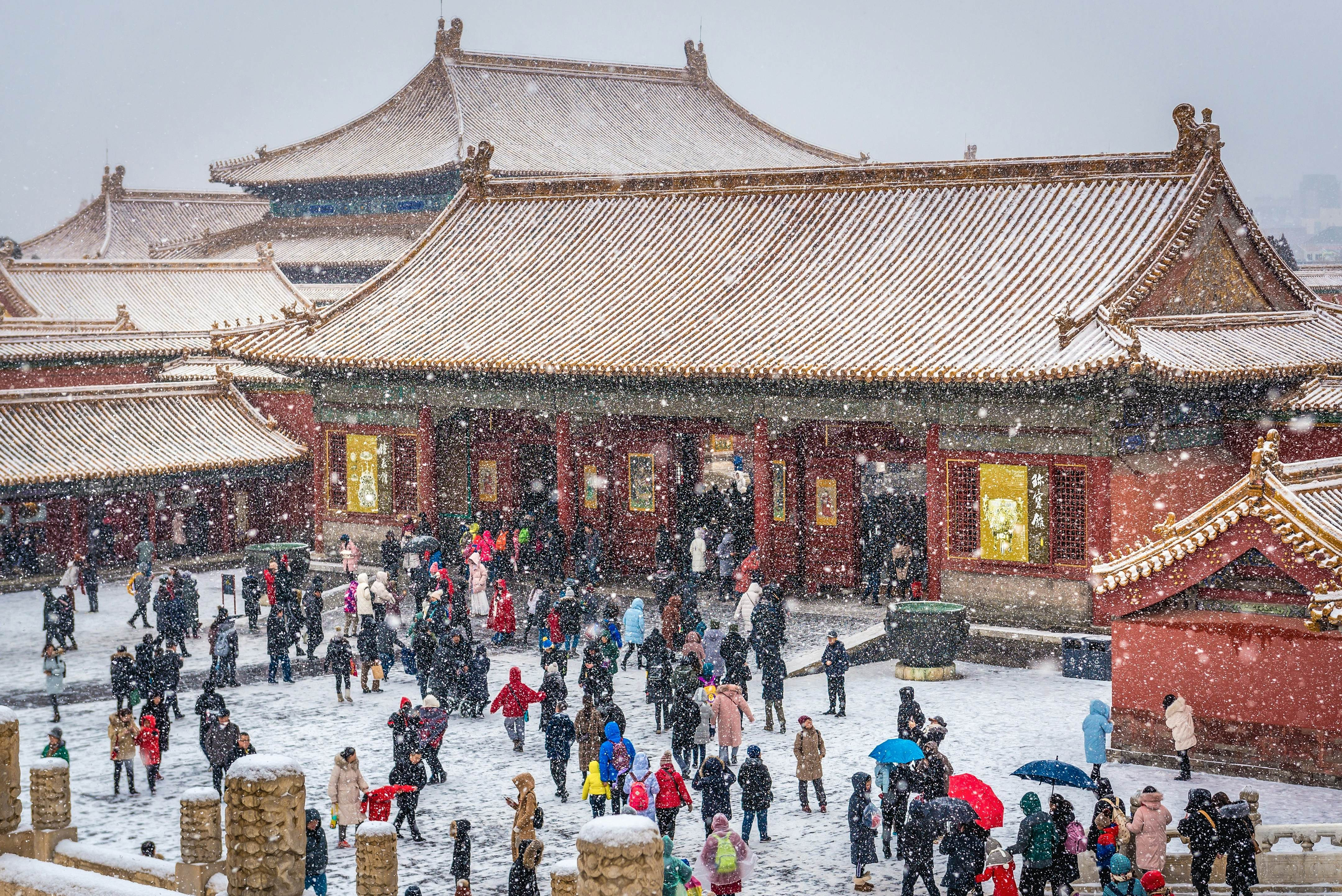 As side gate of the Hall of Preserving Harmony on a snowy day, Forbidden City, Beijing, China
As side gate of the Hall of Preserving Harmony on a snowy day, Forbidden City, Beijing, China
14.1 What Can Visitors See Inside the Forbidden City?
Visitors can explore the grand halls and courtyards of the Forbidden City, including the Hall of Supreme Harmony, the Hall of Central Harmony, and the Hall of Preserving Harmony. Visit the Palace Museum, which showcases artifacts and exhibits related to the history and culture of the imperial court. Walk through the Imperial Garden, a classical Chinese garden with pavilions, rockeries, and trees.
14.2 How Did the Forbidden City Operate During the Ming and Qing Dynasties?
During the Ming and Qing Dynasties, the Forbidden City was the center of imperial power, serving as the residence of the Emperor and his family, as well as the site of important state ceremonies and government functions, according to the Palace Museum. The Forbidden City was divided into the Outer Court, where state affairs were conducted, and the Inner Court, where the Emperor and his family lived. Access to the Forbidden City was restricted to members of the imperial court and officials with permission, maintaining the exclusivity and mystique of the imperial court.
14.3 What Are Some Tips for Visiting the Forbidden City?
Book tickets in advance, especially during peak season, to avoid long lines. Arrive early in the morning to beat the crowds. Wear comfortable shoes, as you will be doing a lot of walking. Hire a guide or rent an audio guide to learn about the history and significance of the site.
Why Choose SIXT.VN for Your China Travel Needs?
Planning a trip to China can be overwhelming due to the vastness of the country and the complexities of its culture. SIXT.VN offers comprehensive travel services to ensure a seamless and enjoyable experience.
Customized Itineraries
SIXT.VN provides personalized travel itineraries tailored to your interests and preferences. Whether you want to explore historical sites, natural landscapes, or bustling cities, we can create a customized plan that suits your needs.
Convenient Airport Transfers
Arriving in a new country can be stressful, especially with language barriers and unfamiliar transportation systems. SIXT.VN offers reliable and convenient airport transfer services, ensuring a smooth transition from the airport to your hotel.
Hotel Booking Assistance
Finding the right accommodation is crucial for a comfortable trip. SIXT.VN offers a wide selection of hotels to suit every budget and preference. Whether you are looking for a luxury hotel or a budget-friendly option, we can help you find the perfect place to stay.
Guided Tours and Excursions
Explore China’s top attractions with our expertly guided tours. Our knowledgeable guides will provide insights into the history, culture, and significance of each site, enhancing your travel experience.
Flight Booking Services
SIXT.VN offers flight booking services to help you find the best deals on flights to China. Our team can assist you with finding flights that fit your schedule and budget, making your travel planning easier.
24/7 Customer Support
We understand that travel plans can change unexpectedly. SIXT.VN provides 24/7 customer support to assist you with any issues or concerns that may arise during your trip.
Ready to Explore China with SIXT.VN?
Don’t let the challenges of planning a trip to China hold you back. Let SIXT.VN take care of all the details, so you can focus on enjoying your adventure. Contact us today to start planning your dream trip to China.
Address: 260 Cau Giay, Hanoi, Vietnam
Hotline/Whatsapp: +84 986 244 358
Website: SIXT.VN
With SIXT.VN, your journey to China will be unforgettable. Let us help you explore the wonders of this amazing country.
FAQs About Tourism in China
1. What are the visa requirements for visiting China?
Visa requirements for China vary depending on your nationality and the purpose of your visit. Most tourists need a tourist visa (L visa), which requires a valid passport, application form, and supporting documents such as flight and hotel reservations. It’s advisable to check the specific requirements with the Chinese embassy or consulate in your country before planning your trip.
2. What is the best time to visit China?
The best time to visit China depends on the region you plan to explore. Generally, spring (April to May) and autumn (September to October) offer the most pleasant weather in many parts of the country, with mild temperatures and less rainfall.
3. What are some essential phrases to learn in Mandarin Chinese for travelers?
Learning a few basic Mandarin phrases can greatly enhance your travel experience in China. Some useful phrases include:
- 你好 (Nǐ hǎo) – Hello
- 谢谢 (Xièxiè) – Thank you
- 不客气 (Bù kèqì) – You’re welcome
- 请问 (Qǐngwèn) – Excuse me
- 多少钱 (Duōshao qián) – How much is it?
4. How can I get around in China?
China has an extensive transportation network, including high-speed trains, domestic flights, buses, and taxis. High-speed trains are a convenient and efficient way to travel between major cities. Within cities, you can use public transportation such as buses, subways, and taxis. Ride-sharing apps are also available in some cities.
5. What is the currency used in China, and how can I handle payments?
The currency used in China is the Chinese Yuan Renminbi (CNY). Credit cards are not as widely accepted in China as in some other countries, especially outside of major cities and tourist areas. It’s advisable to carry cash for smaller establishments and local markets. Mobile payment apps like Alipay and WeChat Pay are extremely popular in China.
6. What should I pack for a trip to China?
When packing for a trip to China, consider the season and region you’ll be visiting. Essentials include comfortable walking shoes, appropriate clothing for the weather, any necessary medications, a universal adapter for electronics, and travel-sized toiletries. It’s also a good idea to bring a portable power bank for your devices.
7. Are there any cultural etiquette tips I should be aware of when visiting China?
When visiting China, it’s helpful to be aware of local customs and etiquette. Some tips include:
- Avoid sticking your chopsticks straight up in a bowl of rice, as it resembles incense offerings for the deceased.
- Refrain from blowing your nose loudly in public.
- Show respect to elders and authority figures.
- Be mindful of personal space in crowded areas.
8. What are some popular souvenirs to buy in China?
China offers a variety of unique souvenirs to bring back home. Some popular options include silk products, tea sets, porcelain, calligraphy scrolls, traditional handicrafts, and local snacks.
9. How safe is it to travel in China?
China is generally considered a safe country for tourists. However, it’s important to take standard safety precautions, such as being aware of your surroundings, safeguarding your belongings from pickpockets, and avoiding scams.
10. What are some common scams to watch out for in China?
While China is generally safe, it’s wise to be aware of potential scams targeting tourists. Some common scams include:
- Tea ceremony scams, where tourists are lured into expensive tea houses.
- Art student scams, where individuals approach tourists claiming to be art students and invite them to galleries to purchase overpriced artwork.
- Taxi scams, where drivers overcharge or take longer routes.
By being cautious and informed, you can avoid these scams and have a safe and enjoyable trip to China.



